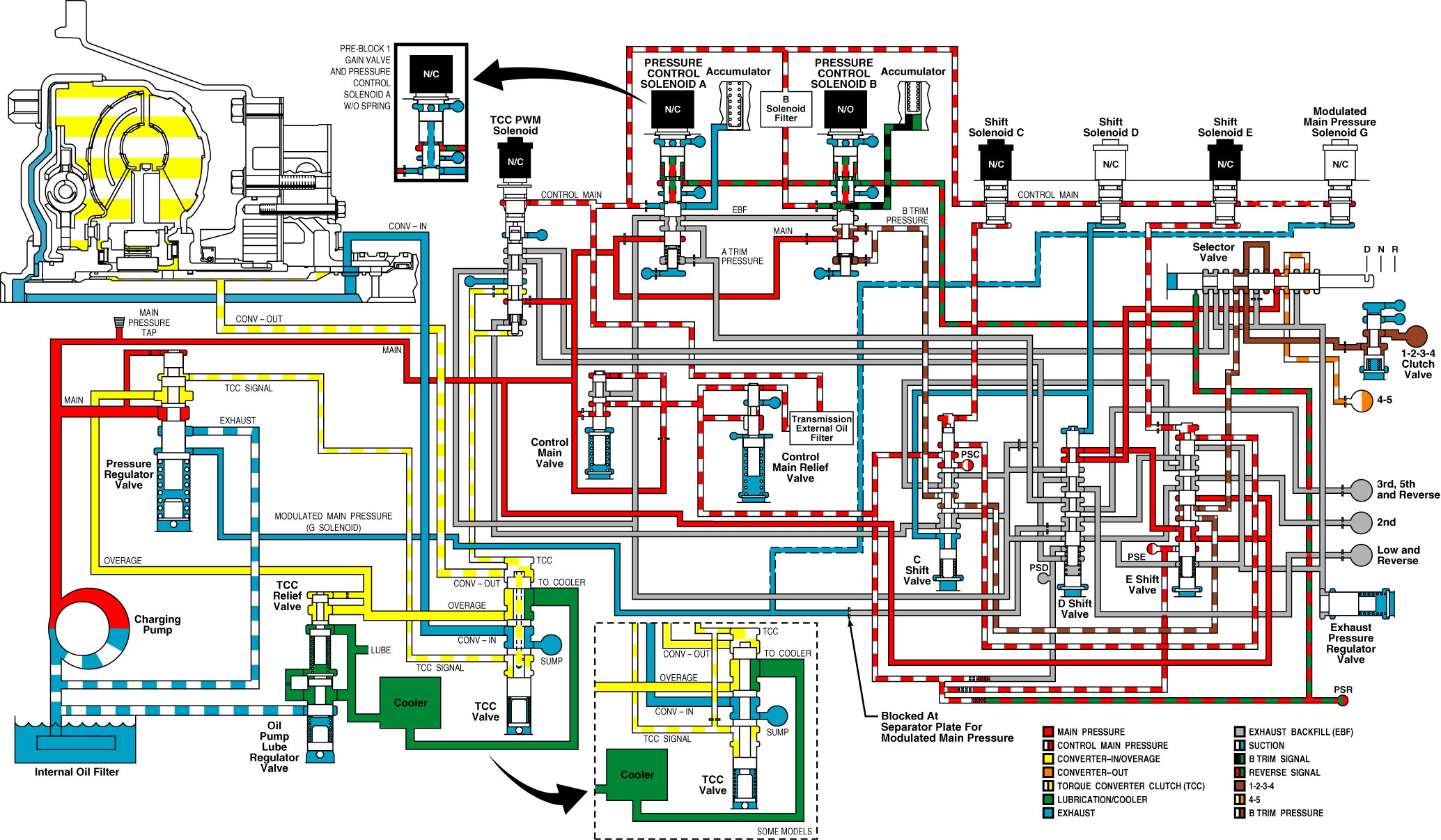Before making the shift from third to fourth range, the transmission control module (TCM) makes certain all of the shift valves are in the correct position, with shift valve C down and shift valves D and E up.
Pressure control solenoid A is energized, opening the A trim signal pressure to exhaust which allows the A trim valve to move up and the 3rd, 5th, and Reverse clutch pressure is exhausted. Pressure control solenoid B is energized, raising the B trim signal and B trim pressures. The B trim pressure is directed through shift valve C, shift valve E, shift valve D and the manual valve to the 4-5 clutch, applying the clutch. Main pressure continues to flow through shift valve E and the manual valve to the 1-2-3-4 clutch, keeping the 1-2-3-4 clutch applied. The TCM supplies current to pressure control solenoid B, which controls the rate at which trim valve B supplies pressure to the 4-5 clutch, and current to pressure control solenoid A, which controls the rate at which trim valve A exhausts the 3rd, 5th, and Reverse clutch, assuring a smooth transition to fourth range.
The combination of the 1-2-3-4 clutch and the 4-5 clutch application produces fourth range operation.
After the shift to fourth range is completed, shift solenoid E is energized, directing control main pressure to the top of shift valve E, pushing the valve down. In the downward position, main pressure is redirected through shift valve D and the manual valve to the 4-5 clutch, keeping the 4-5 clutch applied. The flow from the B trim valve to shift valve E is directed through the manual valve to the 1-2-3-4 clutch, keeping the 1-2-3-4 clutch applied.
Pressure switch E turns on and pressure switch C remains on, providing feedback that the valves are stroked down. Pressure switch D remains off, providing feedback that shift valve D is in the up position.
If electrical power is interrupted with the transmission in fourth range, shift solenoids A, B, and the torque converter clutch pulse width modulated (TCC PWM) solenoid, and shift valve solenoids C and E are de-energized. Shift valve C moves before shift valve E, directing control main pressure to the top of shift valve E, "latching" it in the down position. Main pressure continues to flow through shift valves E and D and the manual valve to the 4-5 clutch, keeping the 4-5 clutch applied. When de-energized, the normally open pressure control solenoid B exhausts the B trim signal pressure, allowing the B trim valve to move up and the 1-2-3-4 clutch exhausts. After shift valve C moves up, the 1-2-3-4 clutch exhausts to exhaust backfill. Normally closed pressure control solenoid A blocks the exhaust of A trim signal pressure, allowing the A trim signal and A trim pressures to rise. Trim valve A directs full trim pressure through shift valve D to the 3rd, 5th, and Reverse clutch, applying the clutch. The combination of the 4-5 clutch and the 3rd, 5th, and Reverse clutch applied produces fifth range operation for a limp home capability. If the torque converter clutch (TCC) is applied, de-energizing the TCC PWM solenoid causes the TCC PWM valve to move up, exhausting pressure from the top of the converter flow valve. The converter flow valve moves up, redirecting main overage to converter in and converter out to the cooler. The TCC is now released.
If electrical power is interrupted with the transmission in fourth range, causing fifth range converter operation, and the manual valve is moved to Neutral (N), the 4-5 clutch exhausts through the manual valve to exhaust backfill, releasing the 4-5 clutch. The 3rd, 5th, and Reverse clutch remains applied. With only one clutch applied, the transmission goes to Neutral (N).
If electrical power is interrupted with the transmission in fourth range, causing fifth range converter operation, and the manual valve is moved to Reverse (R), the 4-5 clutch exhausts through the manual valve, releasing the clutch. The 3rd, 5th, and Reverse clutch remains applied. With only one clutch applied, the transmission goes to Neutral (N).
If electrical power is interrupted with the transmission in fourth range, resulting in only fifth range and Neutral (N) operation, the engine may be shut down and restarted to attain Neutral (N), third and Reverse (R) operation.
Fourth Range

